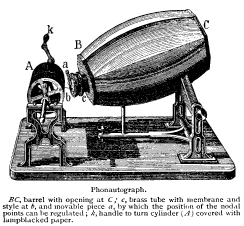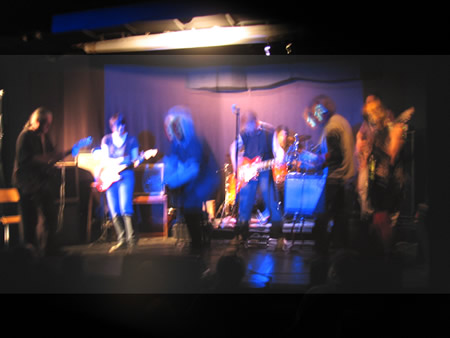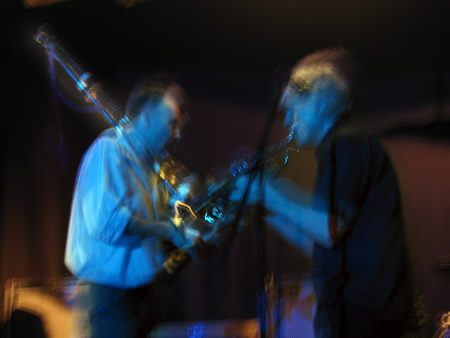Au clair de la lune
march 30, 2008.
Did you already have the chance to hear the 10
second recording ![]() of (a woman (?) singing) the french folk song 'Au
clair de la lune', a recording that recently was found in the form of
a phonautogram made on the 9th of april, 1860?
of (a woman (?) singing) the french folk song 'Au
clair de la lune', a recording that recently was found in the form of
a phonautogram made on the 9th of april, 1860? 
The date makes it among the earliest known, and the earliest known surviving
and audible (recognizable) recording of sound. (Also Thomas Alva
Edison was into folksy tunes, as apparently he recited the beginning
of 'Mary had
a little lamb' in 1877 to test his phonograph; but that recording
did not survive ... I find it interesting that both inventors tested their
invention by singing - or having someone sing for them and their machine
- a popular tune ...)
Before the discovery of the french phonautogram in a parisian archive
some weeks ago, the earliest surviving sound recording was thought
to be Frank
Lambert's cylinder recording for a talking clock, said to be from 1878
(though some historians do think that actually is from a later date).
As a matter of fact, Édouard-Léon Scott de Martinville, who invented the phonautograph, never intended the recordings made on his machine to be played back, and he certainly did not know how to do that. His goal was to write the sound - with a stylus attached to a horn-like barrel (as in the drawing above), onto a piece of paper blackened by the smoke of an oil lamp - and then analyze the sound by studying the patterns thus obtained.
The Scott phonautograms were found by the american audio-historian David Giovanni, who went looking for them in parisian archives. Eventually several of Scott's recordings were found. In the archives of the Institut National de la Propriété Industrielle, and in those of the Académie des Sciences. High resolution scans of the original 'paper records' were made, and then were 'played back' using software that I guess one could compare to a 'virtual record player' ( * ). There is a detailed story by Jody Rosen on the discovery in the march 27th edition of the New York Times ('Researchers play tune recorded before Edison').
David Giovanni is member of a collective called 'First Sounds' ( ** ), dedicated to the study and preservation of our world's earliest sound recordings. On the collaborative's website there are a couple of 'renderings' of other, even earlier (1857) Scott autographs. These however lack the relative audibility of the 'Au clair de la lune' fragment, hence the charm of this mysterious 'ancient' female (?) voice sounding back to us from long ago, through a dense mist of noise and cracklings.
The phonautograph story reminded me of another one that I ran into two years ago, when here and there on the (anglophonic) web it was announced that a team of belgian researchers had succeeded in extracting sounds from thousands of years old pottery. The belgian researchers (virtually) 'played back' scans of the grooves made by the vibrations of the tools used to decorate the vase. The sounds, it said, included talking and laughter, and there was a short (french spoken) video that showed the vase and the researchers, and played some of the talking (in latin). The faculty mentioned in the short reportage though was soon found to be non-existing, and the whole thing actually was merely a short 'docu-fiction', 'Vases sonores', by a young belgian film maker named Bilge Sehir. His website, which seems not to have been updated for quite a while, has a page dedicated to the film, including pictures, a link to the 'trailer', and the promise that the full version of the 'documentary' will be available soon. That page is dated march 2005. ( ** ) [ Variants on the idea actually have been used with some regularity in science fiction stories. It also occurs in the plot of an episode of the television series the X-files. ]
When one imagines the principle of analog sound recording - the inscription of (an image of) the vibrations caused by the sound as a 'linear' trace on a physical support - the idea that a such recording might come about accidentally and unintentionally is pretty attractive. Indeed, why not? But then of course there is the question as to how such accidents might happen, how such 'recordings' might survive the wear of time, and how one might be able to 'recognize' them ... If one considers the case of a 'pottery recording', I guess that even when crooning 'Frère Jacques' on the top of your lungs while holding a needle to carve decorative circles onto a turning piece of clay, it will not be an easy job to extract your singing from a 'playing back' of these grooves. Even given the most advanced of sound 'cleaning and extraction' algorithms. But of course these are the sort of experiments one might conduct. The problem being not to show that is possible to record sound onto a vase (obviously one can), but how that may happen 'by accident' ...
In the wake of all the ado about the belgian 'Vases Sonores', the Tenser, said the Tensor blog and the Language Log each (both on february 23rd, 2006) published a well-documented article on the subject. They trace the idea back to a short paper - a letter, really - entitled "Acoustic Recordings from Antiquity", by the 'independent scholar' Richard G. Woodbridge, III. His note was refused by Nature, but then published in the Proceedings of the IEEE (august 1969, pp. 1465-6). You can find Woodbridge's full text in Tensor's 'Pottery Recordings'. The Language Log article is by Benjamin Zimmer and called A phonographic phony.
Analog recording of sounds needs a movement, to parallel the sound's 'path through time', and Woodbridge - remarkably - highlights two creative movements as possible carriers and 'recorders' of sounds produced at the 'time of creation'. We already talked about the first, being that of tracing decorative lines in a turning piece of pottery. The second option Woodbridge discusses starts from the observation that a painter's canvas may act as a primitive microphone, being a 'membrane' that may vibrate freely in reaction to surrounding sounds. Now Woodbridge suggest that such sounds might be 'recorded' onto the canvas in a paint stroke applied to the surface with an artist's brush ... Now this is a smart and wild idea if ever I heard one, but I have not found any evidence that Woodbridge's claim ever has been confirmed. Woodbridge himself in his note states that he was able to identify short snatches of the original music played, when gently stroking such paint strokes after drying ("at as close of the original stroke speed as possible") with a simple "crystal cartridge such as is used in phono pickups [...] connected directly to a set of inexpensive earphones". Most commenters agree that this 'sounds' too good to be true, and that it is probably largely wishful thinking on Woodbridge's part, but - again - it does seem to be something interesting to experiment with; certainly given powerful software for signal-from-noise separation ...
Both examples discussed by Woodbridge come with a 'natural' preservation of the 'recordings': the pottery is baked and glazed, and most painters protect the strokes on their canvasses by varnish ... However farfetched it might be, isn't it a fantastic idea, that thus works of visual art might carry traces of the environmental sound at the time of their creation? May be found to contain records of the time they were made?
One may imagine similar processes in nature, like the one noted by N. Pearson, of a "smooth lava flow moving past a sharp 'needle' of melting-resistant rock" ... All very enticing indeed, no matter how unlikely in the end ...
notes __ ::
(*) In Digital
Needle - A Virtual Gramophone, israeli algorithms engineer Ofer Springer,
creates digital soundfiles of Vivaldi's The Four Seasons from a 2D scan
of an old vinyl record ... [ ^ ]
(**) That name set me thinking: ... 'First Sounds'
... as if nothing ever sounded before ... before our sounds were
recorded. It actually struck me that, in a way, there is a certain
truth in this thought. [ ^ ]
(***)
To the right there is the YouTube version of the belgian video. 'Vases
Sonores' is a great title, don't you think? It made me imagine a host of other
possible ways to elaborate on the theme ...
I mean, other than playing back sounds unknowingly and unintentionally recorded
by and at the time of the process of the vase's decoration. Watching the
film, if you speak french it is sort of obvious that this is a
fake. Which explains why in february 2006, almost a year after
its production, the 'item' for a while rippled along a number of anglophonic
blogs, before being debunked. (Observed november 2010: The Vases
Sonores clip is no longer available at YouTube's. You may now view
it at Dailymotion, though.) [ ^
]
comments for « au clair de la lune » ::
|
Comments are disabled |
"I did not need that string anyway ..."
march 16, 2008.
I shot the short YouTube 'tourist video' to the right saturday evening with my Canon Powershot at the Studio Campus, in the rue de Froment, Paris XI, during Reverberations Paris - New York, a nice small-scale concert that was organized by Rhys Chatham (who by now has been living here almost forever) and friends. The video shows you some - pretty much randomly picked - excerpts from the second part of the three part evening, with Chatham performing his classic NY post-punk Guitar Trio from 1977, ensemble with Martin Wheeler, David Linton, Jean-François Pauvros and Nina Canal (all on guitar), Francis Pierot on bass and Pascal Bence on drums.
The Guitar Trio (click here to read the performance instructions) is a bit like the bigger-than-life enlargement, the blow-up, of a run-of-the-mill one chord rock coda; it's slowly building up and then goes on, and on, and on ... It's a great piece. And what's more: everybody was having such a great time! It is pretty seldom these days - unfortunately - that I find myself watching and listening to musicians that are performing a piece with such broad smiles - ear to ear - all the way ... and how rare it is to have such fun seeing musicians having such fun while performing a piece ... So in a way it was a relief really, to see Chatham's G3, and one more sign that I must have been going too often to see concerts where both performers and attendees take themselves way too seriously, and attending such events consequently becomes an awful lot like attending sunday's mass ... While, obviously being dead serious and having a ball may go very well together ...
 |
Yes, the Chatham Guitar Trio was a blast! So much so, that it maybe was only natural that the third and last part of the soirée was something of a comedown. Rhys seemed to have overdone just a wee bit the partying during the intermission, and notwithstanding some fine individual moments, the improvisation of the quintet consisting in Chatham (trumpet, guitar), Martin Wheeler (guitar), Jean-François Pauvros (guitar), David Linton (radio, drums) and David Watson (bagpipes) just didn't manage to take off ... Oh, and in case you should wonder, you did see that right: bagpipes. David Watson plays the bagpipes. Now, of course already all by themselves the bagpipes are an amazing instrument. They became even more so in the arms of David Watson.
 |
To give you an impression, here is the last of a four part video made by the SASSAS (which stands for 'Society for the Activation of Social Space through Art and Sound') of Watson playing his bagpipes in the Schindler House in West-Hollywood, in august 2007:
On Chatham's website you'll find his Composer's Notebook, a paper written in 1990. Besides a short description of how western music got to be 'post-modern', the paper contains Chatham's personal recollections of his Werdegang as an actor within the New York (minimalist) art music scene of the late 1970s/early 1980s in the days that (post-)punk rock came around and shook things up quite a bit. Chatham's personal reflections on art, rock and other musics make for interesting reading, in as much that despite all reflection and all theory his own position appears to remain resplendently ambiguous. I like that.
At the end of the video that I made at Studio Campus you see that he broke one of his strings. Chatham walks up to the microphone, and says: "I did not need that string anyway ..." The video stops there, but on stage he then stepped aside and mumbled: "It's only folk music ..."
Oh and, btw, Rhys Chatham continues to tour quite a bit with his Guitar Trio, 'employing' for each next concert a number of 'local' guitar players. Which is yet another fine concept and fun idea ... You can look up dates and places on his MySpace page.
comments for « "i did not need that string anyway ..." » ::
|
Comments are disabled |